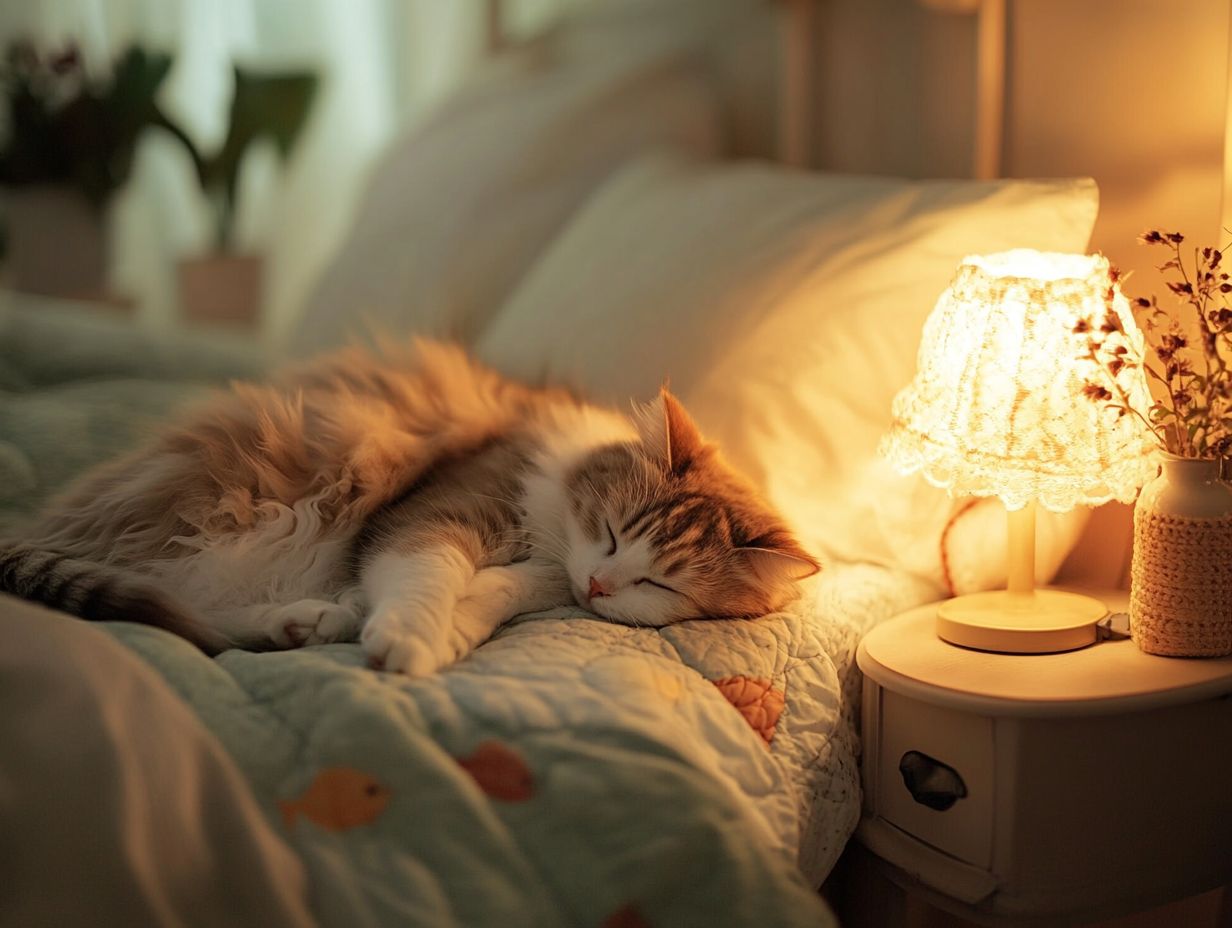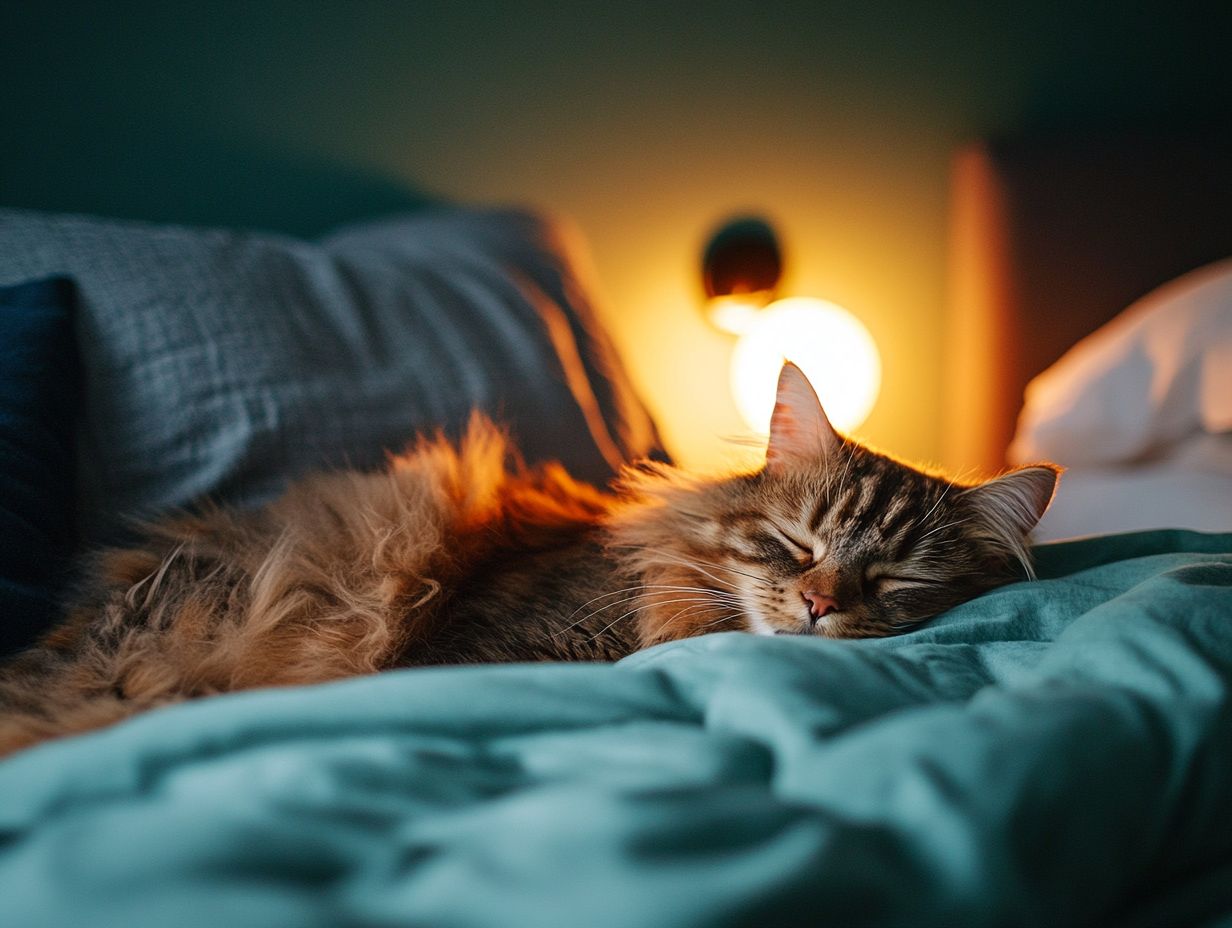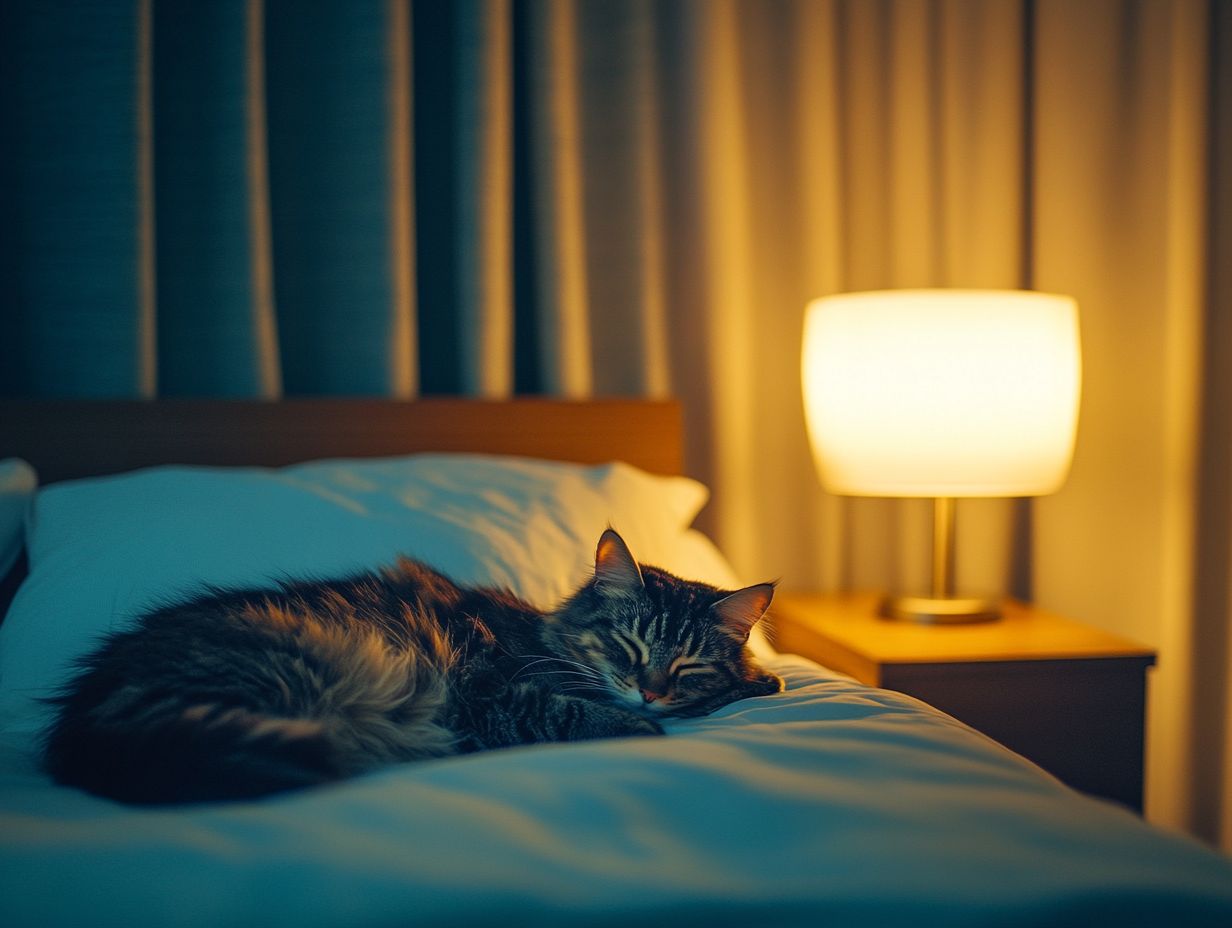Deciding whether to let your cat sleep with you can be a tough choice for any pet owner. It’s essential to consider not just your needs, but also your cat’s perspective, including their natural behaviors and needs in a sleeping environment.
While the cozy companionship of a purring feline can be comforting, it also comes with its own set of challenges. This article explores the risks and benefits of sharing your bed with your cat, how it might impact your sleep quality, and important hygiene considerations.
If you prefer a solo sleeping arrangement, we’ll provide tips on training your cat to stay in its own bed. Join us as we navigate this furry dilemma!
Key Takeaways:

Is It Safe for Cats to Sleep with Humans?
The question of whether it is safe for cats to sleep with humans encompasses considerations of health, emotional well-being, and the bond between cats and their owners. While many people enjoy sharing their bed with their pet cat, there are both risks and benefits associated with this practice. According to studies published in veterinary journals, these factors can significantly affect both humans and animals.
Factors such as dander, allergies, and the cat’s behavior can influence the decision, making it challenging for owners to ensure the safety of everyone involved. Individual variations among cats, including breed, personality, and past experiences, also play a crucial role in their sleeping habits and behaviors.
What Are the Risks of Letting Your Cat Sleep with You?
Allowing your cat to sleep with you comes with several risks that all pet owners should be aware of, particularly concerning health. For instance, cat dander and saliva can trigger allergic reactions in sensitive individuals, leading to discomfort or exacerbated respiratory issues.
Additionally, there is an increased risk of exposure to parasites such as fleas and ticks, which can also pose health risks for humans. Cats are known to carry pathogens that can cause health conditions like cat scratch disease and respiratory infections. Therefore, while sharing your bed with your pet may strengthen the bond between you, it is important to consider these potential health implications.
What Are the Benefits of Letting Your Cat Sleep with You?
Allowing a cat to sleep with you offers several benefits, including improved emotional health, a stronger bond between owner and pet, and a warm, comforting routine. Shared sleep experiences can significantly reduce anxiety; studies indicate that a cat’s purr creates a calming environment that fosters relaxation.
The presence of a furry companion can elevate one’s mood, providing a sense of safety and comfort. Over time, the close relationship and familiarity between human and pet build trust, further strengthening their bond. Overall, permitting a cat to sleep beside you enhances restful sleep and nurtures the heart.
How Does Sleeping with a Cat Affect Your Sleep Quality?
The impact of sleeping with a cat on sleep quality varies and is influenced by personal preferences and the cat’s nighttime behavior. For some individuals, the warmth and purring of a cat can enhance sleep, while for others, the cat’s actions may disrupt their rest.
The owner’s relationship with the cat, including levels of trust and comfort, as well as their energy levels and nighttime habits, all play a role in determining whether sleeping with a cat improves or diminishes sleep quality.
Does Having a Cat in Bed Disrupt Your Sleep?

Yes, having a cat in bed can disrupt sleep due to their natural behaviors, such as purring, stretching, and occasional playfulness, which interfere with the quiet atmosphere conducive to rest.
For instance, when a cat feels frisky, it may jump around and bat at imaginary prey, startling a sleepy person. Additionally, the sounds of a cat grooming itself or shuffling about, although subtle, can be surprisingly disruptive throughout the night.
Tips for Minimizing Sleep Disruption
- Provide a separate cozy space for your cat nearby.
- Engage them with toys before bedtime to tire them out.
Understanding Feline Body Language
Common cues indicating whether a cat is comfortable or anxious about sharing a sleeping space include:
- Tail position: High and relaxed indicates comfort; low or tucked suggests anxiety.
- Purring: Generally a sign of contentment.
- Restlessness: Moving around frequently may indicate discomfort.
Potential Problem Behaviors in Cats During Sleep
Some cats may exhibit nocturnal playfulness or restlessness. If your cat is disruptive at night, consider the following troubleshooting steps:
- Increase daytime playtime.
- Establish a calming bedtime routine.
The Human-Cat Bond
Sharing sleeping arrangements can impact feline cognition and behavior. Strengthening this bond may lead to improved behavior in both cats and humans.
Signs of Stress and Anxiety
When sharing a bed, watch for signs of stress in your cat, such as hiding or excessive grooming. Strategies for creating a calming sleep environment include:
- Using calming scents like lavender.
- Providing a quiet, dark sleeping space.
Multi-Cat Households
When multiple cats are involved in a shared sleeping arrangement, dynamics may change. Be mindful of territorial behavior and provide separate spaces if conflicts arise.
Behavior Modification Steps
For cats exhibiting disruptive behaviors at night, consider a positive reinforcement training approach:
- Identify the disruptive behavior.
- Reward desired behaviors with treats.
- Be consistent with training.
When to Seek Professional Help
If sleep-related issues persist, consult with a veterinarian or animal behaviorist to address behavior modification or health concerns.
Assessing Suitability for Bed-Sharing
Use the following checklist to assess your cat’s suitability for bed-sharing based on individual behavior and health considerations:
- Does your cat have a history of stress or aggression?
- Is your cat regularly groomed and healthy?
Myth-Busting
Common misconceptions about cats sleeping with humans can be misleading. For example, some believe that all cats disrupt sleep, but many owners find comfort in their presence.
Preventive Measures
Creating a comfortable sleeping environment for both cats and owners is essential. Proactive strategies include maintaining a clean sleeping area and ensuring your cat is healthy before bed-sharing.
The Health Connection
Before finalizing sleeping arrangements, it’s vital to rule out any medical causes of sleep disruptions in cats, as these issues can impact both your sleep quality and your cat’s health.
Ongoing Learning
For further insights into feline behavior and sleep health, consider resources such as books or online courses dedicated to understanding your pet better.
If a cat seeks attention, it might paw or nudge you, making it challenging to maintain deep sleep. These interruptions can negatively impact sleep continuity and quality, often leaving one feeling groggy and unrested in the morning. Research indicates that sleep disturbances caused by pets, particularly cats, can disrupt the natural sleep cycle, affecting overall well-being and cognitive function.
Can Sleeping with a Cat Help with Anxiety and Stress?
Sleeping with a cat can be an effective way to alleviate anxiety and stress. The presence of a warm, purring cat creates an emotionally soothing environment that enhances mental well-being. This calming atmosphere can help lower cortisol levels, known as the stress hormone, fostering feelings of security and connection that many people crave. From the cat’s perspective, seeking companionship is a natural instinct that provides comfort and warmth, contributing to both the cat’s and owner’s mental health.
Cats produce gentle purring sounds that are almost meditative; research has shown that these sounds can lower heart rates and have a calming effect. Moreover, individual differences in breed, genetics, and past experiences can influence a cat’s need for attention and sleeping habits.
Additionally, petting a cat triggers the release of oxytocin in the human brain, which reinforces the bond between pet and owner, promoting feelings of happiness and relaxation that contribute to overall mental wellness.
What Are the Hygiene Concerns of Sleeping with a Cat?
Hygiene concerns associated with sleeping with a cat are important factors that may affect your decision to share your bed with your feline companion. Issues such as cat dander, parasites, and the necessity for regular cleaning of bedding and the surrounding environment can raise health and comfort questions. Myth busting around hygiene suggests that while some dander is present, regular grooming and cleaning can significantly reduce allergen levels, allowing for a healthier shared space.
By understanding these concerns, you can create a more suitable sleeping arrangement that prioritizes both your well-being and that of your cat.
Is It Unsanitary to Let Your Cat Sleep in Your Bed?
Allowing your cat to sleep in your bed raises legitimate concerns regarding hygiene and sanitation, including issues related to dander, parasites, and potential allergens. A study by the American Institute of Physics indicates that dust mites, which thrive in pet hair, along with the risk of fleas and ticks nesting in bedding, can exacerbate respiratory illnesses and trigger allergic reactions, particularly in sensitive individuals.
Effective solutions involve regularly washing bedding and using hypoallergenic covers, as well as grooming your cat frequently to minimize dander and other irritants. It’s also important to recognize signs of stress in cats and implement strategies to reduce anxiety related to sleeping arrangements.
How Can You Minimize the Risk of Infection from Sleeping with a Cat?
To reduce the risk of infection from sleeping with a cat, owners should practice proper hygiene and schedule routine veterinary visits. These measures help minimize potential infections from the environment and ensure the health of the pet. Such practices are essential not only for those who sleep with a cat but also for overall responsible pet ownership.
Regular grooming routines are important for pet owners as they help reduce shedding and dander, thereby lowering the presence of potential allergens and pathogens that could be harmful to both pet and owner. Additionally, cleaning bedding and other areas where the pet and owner frequently sleep can further diminish the risk of infection by creating a less hospitable environment for harmful bacteria and parasites.
Seeking veterinary advice on preventive health measures, including vaccinations, flea treatments, and other medications, can also help ensure the health of both the pet and the owner. Practicing environmental enrichment through play can also decrease the cat’s dependence on human interaction for comfort.
How to Train Your Cat to Sleep in Its Own Bed?

Training your cat to sleep in its own bed is a rewarding process that enhances comfort for both the owner and the cat. This practice not only fosters a sense of security for the pet but also promotes positive routines and develops healthy sleeping habits for both. Using positive reinforcement techniques, such as treats or affection, can encourage your cat to sleep in its own bed without the use of punishment.
It involves the owner gaining an understanding of their pet’s behavior and preferences while gradually teaching the cat to sleep in its designated space. Addressing potential underlying causes of sleeping issues, such as anxiety or a desire for warmth, can help tailor your approach to training.
What Are the Steps to Train Your Cat to Sleep in Its Own Bed?
Training your cat to sleep in its own bed can be achieved through a few simple steps. This process relies on positive reinforcement and consistency while respecting your cat’s natural behaviors and habits. Incorporating activities or toys that encourage independent sleeping habits can also be beneficial.
In multi-cat households, it’s essential to manage resources to ensure all cats feel secure. When transitioning your cat, providing a comfortable environment in its own bed is crucial. If challenges persist, it may be advisable to seek guidance from a veterinarian or animal behaviorist.
Ultimately, prioritizing your cat’s well-being and understanding its needs will lead to a harmonious sleeping arrangement that benefits both pet and owner.
-
Begin by placing the new bed in a quiet, comfortable area of your home where your cat already feels safe. If you’re wondering about the implications of sharing your bed with your feline friend, consider reading this article: Should I Let My Cat Sleep With Me? Weighing the Pros and Cons.
-
Next, encourage your feline friend to spend time in this new space by adding familiar items, such as a favorite blanket or toy, to the bed. Toys that mimic hunting behaviors, like feather wands or laser pointers, can stimulate your cat’s instincts during playtime.
-
To foster positive associations, offer treats or gentle petting when your cat approaches or interacts with the new bed. Consistency is key; using specific treats like freeze-dried chicken or catnip-infused snacks can be effective.
-
Finally, reward your cat each time it uses its new bed, helping it become more comfortable with this sleeping arrangement.
With time and consistent encouragement, your cat can successfully learn to sleep in its own bed.
What Are Some Tips for Successfully Training Your Cat to Sleep in Its Own Bed?
Here are some tips for training your cat to sleep in its own bed, which can enhance the likelihood of success by creating an inviting and comfortable environment:
- Make the bed more appealing by adding a few minor updates, like incorporating the Hepper Nest Bed for ultimate comfort.
- Use soft, warm blankets that can replicate your own warmth, inviting your cat to safely cuddle with you.
- Choose a quiet, cozy location away from distractions, ensuring your cat feels safe and the environment is conducive to restful sleep.
- Consider adding a piece of your clothing to provide a familiar scent.
- Offer positive reinforcement, such as treats or praise, for even small successes. Mix verbal praise with physical affection for a more rewarding experience.
What Factors Should You Consider Before Deciding to Let Your Cat Sleep with You?
Before deciding whether to let your cat sleep with you, it is essential to consider several factors, including your cat’s behavior, health conditions, and your own comfort level with closeness, as well as potential risks like allergies and dander. According to a study published in the Journal of Feline Medicine and Surgery, pet dander can exacerbate allergies and respiratory issues (source needed).
- Your Cat’s Temperament: Cats vary in their affinity for cuddling and close contact with humans. Some cats are quite affectionate and enjoy sleeping close to their owners, while others prefer their own space.
- Your Health Conditions: Another crucial consideration is whether allowing your cat to sleep with you poses any health risks, including allergies and respiratory infections. Allergic reactions to dander are a common reason for not permitting pets in the bedroom. Additionally, parasites such as fleas, ticks, and worms, as well as bacteria like E. coli, can be transmitted from pets to humans (source needed).
- Emotional Factors: The human-pet dynamic can significantly impact sleep quality and emotional well-being. Studies have shown that human-animal bonding can reduce stress and anxiety levels for both parties, enhancing emotional health (source needed).
- Individual Habits: Both behavioral and physical habits play a role in this decision. Some cats may groom themselves or their owners at night, which can be endearing but may disrupt sleep. Others may restlessly roam or jump on their owners, affecting their sleep quality.
By considering these factors holistically, you can make the most appropriate decision regarding whether to let your cat sleep with you. For more insights, and to understand the benefits and potential risks, check out Should I Let My Cat Sleep With Me? Weighing the Pros and Cons.
Guidelines for Introducing a New Bed
When introducing a new bed to a cat that may be anxious or resistant, gradual acclimation is crucial. Start by placing the bed in a familiar area and allow your cat to explore it at its own pace. Use soft, inviting bedding and incorporate calming scents like lavender to create a safe space.
Common Problems and Troubleshooting
If your cat is resistant to sleeping alone, consider underlying causes such as anxiety or past trauma. Address these by providing a consistent routine, positive reinforcement, and gradually increasing the time spent away from you while ensuring your cat has ample enrichment in its environment.
Behavioral Differences Across Developmental Stages
Understand that age can influence a cat’s sleeping preferences and habits. Kittens may prefer closeness for warmth and security, while adult cats might develop their own sleeping patterns. Senior cats may seek more comfort and security, often requiring softer bedding and a quieter environment.
When to Seek Professional Help
If problematic sleeping behaviors persist, it may be time to consult a veterinarian or animal behaviorist. They can provide tailored solutions and assess for underlying medical conditions that may be affecting your cat’s sleeping habits.
Frequently Asked Questions
Can I let my cat sleep with me?

Yes, you can let your cat sleep with you. It is ultimately a personal choice and depends on your preferences and lifestyle.
What are the pros of letting my cat sleep with me?
Having your cat sleep with you can provide comfort and a sense of companionship. It can also help strengthen the bond between you and your cat, offering therapeutic benefits through purring and warmth.
Are there any cons to letting my cat sleep with me?
Yes, potential cons include disrupted sleep patterns, allergies, and the risk of transmitting zoonotic diseases. Always weigh the pros and cons carefully.
There are a few potential drawbacks to letting your cat sleep with you. These include potential sleep disruptions, allergies, and the risk of your cat bringing in unwanted pests, bacteria, or even parasites like ringworm or cat scratch disease from outside. According to the American Veterinary Medical Association, it’s essential to monitor your cat’s health regularly.
Should I be concerned about my cat’s health if they sleep with me?
If your cat is generally healthy and up-to-date on their vaccinations, sleeping with you should not pose major health risks. However, if you have a weakened immune system or are pregnant, it may be best to avoid sleeping with your cat due to the potential for diseases or parasites. Consulting your veterinarian is advisable. Emotional aspects also play a role; the companionship can enhance well-being for both you and your cat.
Is it possible to train my cat to sleep in their own bed instead of with me?
Yes, it is possible to train your cat to sleep in their own designated sleeping area. It may take time, consistency, and the right routine, but with positive reinforcement techniques such as treats or praise when your cat chooses their bed, your cat can learn to sleep in their own bed, like the PangoVet cat bed. Making the area inviting with warm bedding and familiar scents can help.
What factors should I consider before deciding whether or not to let my cat sleep with me?
Some important factors to consider include your own sleep preferences and habits, any health concerns or allergies, and the overall behavior and personality of your cat. Different breeds may have varying tendencies towards co-sleeping, influenced by genetics and previous experiences. It’s essential to weigh the pros and cons and make a decision that works best for you and your cat’s well-being, ensuring a happy and healthy relationship. Additionally, observe your cat’s body language: if they seem relaxed and comfortable, co-sleeping may be beneficial. However, resistance could indicate behavioral symptoms worth exploring further.
Understanding Cats of All Ages
Kittens, adult, and senior cats may display different sleeping habits. Kittens often seek warmth and security, while older cats might prefer solitude or the comfort of their human. Establishing boundaries early on can promote healthy sleep habits and respect the cat’s autonomy.
Addressing Common Myths
It’s a common misconception that co-sleeping always leads to behavioral problems. In fact, it can strengthen the bond between you and your cat, provided both parties are comfortable. Co-sleeping can also alleviate stress, but it may exacerbate anxiety in some cases. Observing your cat’s behavior will help determine what works best.
When to Seek Professional Help
If you notice persistent anxiety or aggression in your cat, it may be beneficial to consult a veterinarian or an animal behaviorist. They can provide tailored advice and strategies for transitioning your cat to sleeping alone, emphasizing patience and consistency.
Additional Learning Resources
For those interested in further exploring cat behavior and care, resources from feline behaviorists and veterinarians can provide valuable insights. Books, articles, and websites dedicated to feline health can enhance your understanding and help maintain a harmonious living environment.